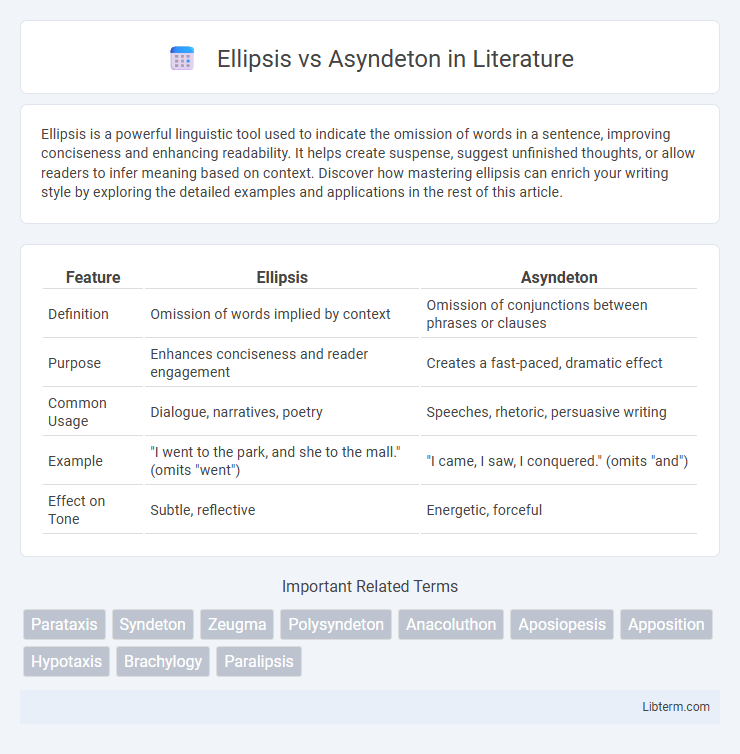Ellipsis is a powerful linguistic tool used to indicate the omission of words in a sentence, improving conciseness and enhancing readability. It helps create suspense, suggest unfinished thoughts, or allow readers to infer meaning based on context. Discover how mastering ellipsis can enrich your writing style by exploring the detailed examples and applications in the rest of this article.
Table of Comparison
| Feature | Ellipsis | Asyndeton |
|---|---|---|
| Definition | Omission of words implied by context | Omission of conjunctions between phrases or clauses |
| Purpose | Enhances conciseness and reader engagement | Creates a fast-paced, dramatic effect |
| Common Usage | Dialogue, narratives, poetry | Speeches, rhetoric, persuasive writing |
| Example | "I went to the park, and she to the mall." (omits "went") | "I came, I saw, I conquered." (omits "and") |
| Effect on Tone | Subtle, reflective | Energetic, forceful |
Introduction to Ellipsis and Asyndeton
Ellipsis and asyndeton are rhetorical devices used to enhance writing and speech by manipulating sentence structure. Ellipsis involves the deliberate omission of words that are implied by context, creating a more concise and impactful expression. Asyndeton features the omission of conjunctions between clauses or phrases, producing a rapid, streamlined flow that emphasizes the connection between ideas.
Defining Ellipsis: Meaning and Usage
Ellipsis is a linguistic device that involves the intentional omission of words or phrases that are contextually understood, enhancing brevity and emphasis in communication. It differs from asyndeton, which specifically removes conjunctions between words or phrases to create a concise, impactful effect. Ellipsis is commonly used in literature and everyday speech to evoke meaning without redundancy, relying on the listener's or reader's ability to infer the missing elements.
Defining Asyndeton: Meaning and Usage
Asyndeton is a rhetorical device that involves the deliberate omission of conjunctions between words, phrases, or clauses to create a concise, impactful statement. This technique enhances the pace and rhythm of the text, often producing a dramatic or urgent effect. Commonly used in speeches and literature, asyndeton emphasizes brevity and intensity by stringing elements together without coordinating conjunctions like "and" or "or.
Key Differences Between Ellipsis and Asyndeton
Ellipsis involves the deliberate omission of words that are implied by the context, enhancing conciseness and allowing readers to fill in gaps mentally. Asyndeton, on the other hand, refers to the deliberate absence of conjunctions between parts of a sentence, creating a faster pace and emphasizing the listed elements. Key differences lie in ellipsis omitting words for brevity, while asyndeton removes conjunctions to produce a distinct rhetorical effect.
Common Functions in Rhetoric
Ellipsis and asyndeton both enhance rhetorical impact by creating concise and impactful expressions, with ellipsis omitting words while retaining meaning and asyndeton eliminating conjunctions to accelerate rhythm. Both techniques contribute to emphasis, enabling speakers or writers to evoke stronger emotions and highlight key ideas efficiently. Their common function lies in engaging the audience through strategic brevity and heightened intensity, making arguments more persuasive and memorable.
Examples of Ellipsis in Literature and Speech
Ellipsis, a rhetorical device involving the omission of words that are implied by context, is famously illustrated in Ernest Hemingway's terse dialogue, such as "I went to the mall, and she to the movies," where the verb "went" is omitted in the second clause. Shakespeare's plays often employ ellipsis for dramatic effect, for example, in "Hamlet," where the phrase "To be, or not to be: that is the question" leaves out words to emphasize the philosophical dilemma. In everyday speech, ellipsis appears in responses like "Want some coffee?" replied to with "I do," where the full sentence is understood but truncated for brevity and impact.
Examples of Asyndeton in Literature and Speech
Asyndeton is a rhetorical device characterized by the omission of conjunctions between phrases or clauses, creating a concise and impactful expression. Notable examples of asyndeton in literature include Julius Caesar's declaration "I came, I saw, I conquered," which emphasizes the swift and decisive nature of his actions. In speech, Martin Luther King Jr.'s "government of the people, by the people, for the people" employs asyndeton to reinforce democratic ideals through rhythmic brevity.
Impact on Tone and Style
Ellipsis, by intentionally omitting words, creates a tone of suspense or urgency, enhancing the reader's engagement through implied meaning. Asyndeton, characterized by the omission of conjunctions, produces a concise, fast-paced rhythm that intensifies emotional impact or urgency. Both rhetorical devices alter sentence flow, with ellipsis fostering a contemplative or dramatic tone while asyndeton delivers a direct, dynamic style.
Choosing Between Ellipsis and Asyndeton
Choosing between ellipsis and asyndeton depends on the desired rhythmic effect and clarity in a sentence. Ellipsis omits words to create a concise, impactful expression while maintaining grammatical coherence, whereas asyndeton removes conjunctions to speed up the pace and generate emphasis through brevity. Writers select ellipsis for subtlety and reader inference, opting for asyndeton when aiming for dramatic or urgent tones in speech or writing.
Conclusion: Mastering Ellipsis and Asyndeton
Mastering ellipsis and asyndeton enhances writing by creating concise, impactful sentences that engage readers. Ellipsis omits unnecessary words, streamlining communication, while asyndeton removes conjunctions to accelerate rhythm and emphasize ideas. Skilled use of both rhetorical devices strengthens clarity, emotional effect, and stylistic elegance in prose and speech.
Ellipsis Infographic

 libterm.com
libterm.com